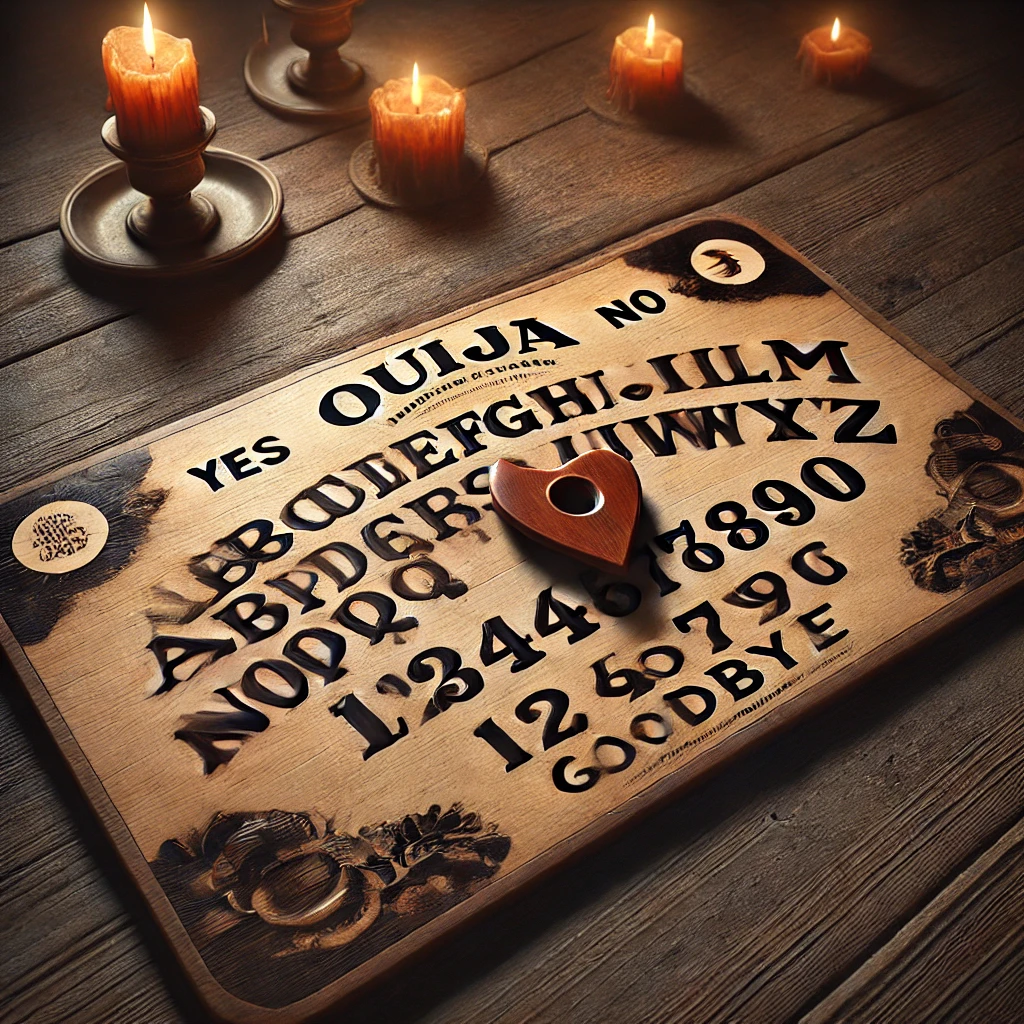Ouija Board

The Ouija board, first marketed as a “talking board” in 1890, quickly gained widespread popularity in the United States. By the 1960s, it was sold as a novelty item and even a children’s toy in countries like Australia, the UK, and the USA. Manufactured primarily by Parker Brothers (now owned by Hasbro), the Ouija board became a household name, captivating the imaginations of millions with its mysterious promise of spirit communication.
Alongside popular games like Monopoly, the Ouija board cemented itself as one of the most commercially successful board games of all time. Despite being marketed for entertainment, its associations with the supernatural and séance culture added to its allure, especially during periods of heightened spiritual curiosity, such as the 1960s. Its cultural impact has persisted for decades, contributing to its lasting presence in popular culture and among collectors worldwide.
The Glow in the Dark Ouija Board commercial from the late 1990s was a product of Hasbro’s efforts to modernize and reintroduce the classic board game to a new generation. This version of the Ouija board featured a phosphorescent surface, making it glow when used in the dark, enhancing the eerie and mystical atmosphere associated with the game.
Aimed at a younger, thrill-seeking audience, the commercial played into the 90s nostalgia for spooky and paranormal entertainment, aligning with the popularity of shows like The X-Files and horror movies of the time. The commercial, often recorded on VHS tapes during its original airing, became a pop culture artifact for those who grew up during the era, appealing to kids and teenagers with its playful yet mysterious tone. The VHS recording format itself further lends a nostalgic element to this era of advertising, as it captures the transitional phase between analog and digital media. The glow-in-the-dark feature made the Ouija board feel even more otherworldly, helping to keep it relevant in a decade fascinated by the supernatural.
The Ouija board was first invented and first marketed as a “talking board” in 1890 by Charles Kennard and his company, the Kennard Novelty Company, in Baltimore, Maryland. Kennard, along with businessman Elijah Bond and others, developed the board with the intention of creating a device for communicating with spirits, capitalizing on the popularity of the Spiritualist movement of the time. The concept was not entirely original, as similar talking boards existed, but Kennard and Bond took it a step further by patenting the design in 1891. The name “Ouija” allegedly came from a session using the board itself, where the letters supposedly spelled out “Ouija” as the name of the board, which they claimed meant “good luck.” Soon after, William Fuld, an employee of the Kennard Novelty Company, took over production and became instrumental in the board’s long-term success, eventually becoming widely recognized as the “father” of the Ouija board. Fuld popularized it and ran with its marketing until his death in 1927, after which the Ouija board was acquired by Parker Brothers in 1966, continuing its legacy as a cultural phenomenon.
In the 2012 study titled “The Supernatural Agency Belief Scale: Validating a Measure of Beliefs in Supernatural Agents and Their Influence”, conducted by researchers at the University of British Columbia, participants were asked factual yes/no questions both verbally and using a Ouija board. When responding verbally, their accuracy hovered around 50%, which aligns with random guessing. However, when participants used the Ouija board, their accuracy improved to about 65%. This suggests that the Ouija board may help access subconscious knowledge that participants were not consciously aware of.
The researchers used trick setups, such as blindfolding participants and secretly removing their partner’s hand from the planchette, to create the illusion that they were not in control. This helped highlight the ideomotor effect, where individuals move objects unconsciously. Participants reported feeling less agency during Ouija sessions, reinforcing the sensation that an external force was guiding them, even though the movements appear to be self-generated. The study concluded that the Ouija board taps into subconscious memory rather than facilitating communication with spirits.
While the 2012 study from the University of British Columbia supports the idea that Ouija boards might tap into subconscious knowledge, alternative spiritual interpretations challenge this explanation. One perspective offered is that Ouija boards may act as gateways for malevolent spiritual entities, rather than simply drawing from the human subconscious. God appears to Permits Demons to Test Humans posits that supernatural tools like the Ouija board can invite demonic forces as a means of testing one’s faith, with demons disguising their influence as innocuous or helpful answers to questions. Similarly, Evil Spirits (aka Demons) suggests that what users interpret as subconscious knowledge could actually be manipulation by dark forces, deceiving individuals into believing they are in control. The Rise of Demonic Influences in the Music Industry and Demonic UFOs explore how demonic entities infiltrate various aspects of modern culture, often under the guise of benign or misunderstood phenomena. From this perspective, the accuracy of Ouija board answers could be attributed not to buried knowledge within the user, but rather to spiritual deception.
Thus, while science offers one perspective on the Ouija board’s effects through the ideomotor phenomenon, spiritual perspectives raise serious concerns about its dangers. Sir Christopher Lee’s warning, highlighted in the article “I Warn All of You, Never, Never, Never,” serves as a profound caution against engaging with occult tools like the Ouija board. He emphasized that such practices could not only risk one’s mental stability but, more importantly, their very soul. This stern warning underscores the spiritual dangers that believers associate with these seemingly harmless tools.

